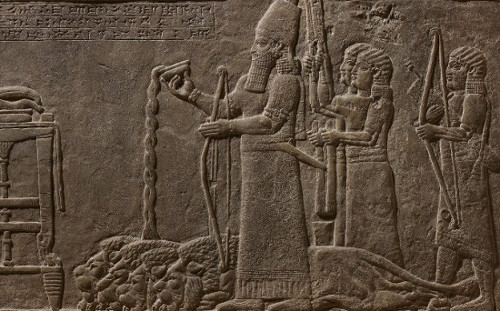You are seeing an unstyled version of this site. If this is because you are using an older web browser, we recommend that you upgrade to a modern, standards-compliant browser such as FireFox [http://www.getfirefox.com/], which is available free of charge for Windows, Mac and Linux.
The Royal Inscriptions of Ashurbanipal and His Successors

After the death of the Assyrian king Esarhaddon in late 669 BC, Assyria, its temples, and its people continued to thrive under Ashurbanipal. During the early part of his reign, the Assyrian Empire reached its greatest extent, possibly covering more territory than any empire the world had known up until that time. However, Assyria's good fortune would not last; its glory faded even while Ashurbanipal sat upon the throne. Within about twenty years after his death in ca. 631 BC, Assyria ceased to exist as a political entity. By 612 BC, its penultimate king Sîn-šarra-iškun was dead and its largest and most important cities, including Aššur and Nineveh, lay abandoned and desolate, destroyed, and plundered by the Babylonians and Medes. The final death blow, however, did not come until three years, later since a certain Aššur-uballiṭ II had declare himself "king of Assyria" in the western part of the empire, in a cult center of the moon-god. In 609 BC, Aššur-uballiṭ and the Assyrian monarchy vanished from the face of the earth.
While 270 different inscriptions, attested by approximately 1,300 separate exemplars, are known for Ashurbanipal, Assyria's last great ruler, only a few are preserved for Aššur-etel-ilāni and Sîn-šarra-iškun, and none for Sîn-šumu-līšir and Aššur-uballiṭ II. Nearly all of the texts are written in the Standard-Babylonian dialect of the Akkadian language, but a few short texts are written in the Sumerian language. Ashurbanipal's texts (which are often referred to as annals) describe his numerous victories on the battlefield -- from Egypt to Iran and from Turkey to the marshes at the head of the Persian Gulf, and against such major states as Egypt, Elam and Babylonia, as well as against Arab tribes and Phoenician cities -- various building enterprises (such as royal palaces, temples, and city walls), and religious dedications (for example, the creation of a gold bow to the goddess Ištar), as well as his scholarly achievements (ability to read, write, do complex mathematics, and understand the practice of divination). The inscriptions range in length from simple one-line possession labels on stone vessels to detailed 1,300-line annalistic texts on clay prisms; some texts may exist in only one copy, while others may be known from approximately 250 exemplars. This website presents all of the royal inscriptions of the five kings of Assyria who ruled northern Iraq from 668 BC to ca. 609 BC, together with a few resources and materials for their study and their historical context. At present, 318 inscriptions of Ashurbanipal (including some written by one of his officials, the governor of Ur), 6 texts of Aššur-etel-ilāni (mostly from Babylonia), and 21 inscriptions of Sîn-šarra-iškun have been edited and lemmatized.
Further reading
Borger, Rykle. Beiträge zum Inschriftenwerk Assurbanipals. Wiesbaden: Harrassowitz, 1996.
Grayson, A. Kirk. "Assyria 668-635 B.C.): the Reign of Ashurbanipal," pp. 142–161 in J. Boardman et al. (eds.), The Cambridge Ancient History, second edition, vol. 3/2. Cambridge, 1991.
Jeffers, Joshua and Jamie Novotny, The Royal Inscriptions of Ashurbanipal (668–631 BC), Aššur-etel-ilāni (630–627 BC) and Sîn-šarra-iškun (626–612 BC), Kings of Assyria, Part 2 (The Royal Inscriptions of the Neo-Assyrian Period 5/2). University Park, 2023. Buy the book from Eisenbrauns [https://www.eisenbrauns.org/books/titles/978-1-64602-223-6.html].
Novotny, Jamie and Joshua Jeffers, The Royal Inscriptions of Ashurbanipal (668–631 BC), Aššur-etel-ilāni (630–627 BC) and Sîn-šarra-iškun (626–612 BC), Kings of Assyria, Part 1 (The Royal Inscriptions of the Neo-Assyrian Period 5/1). University Park, 2018. BUY THE BOOK [https://www.eisenbrauns.org/books/titles/978-1-57506-997-5.html].
Novotny, Jamie, Joshua Jeffers, and Grant Frame, The Royal Inscriptions of Ashurbanipal (668–631 BC), Aššur-etel-ilāni (630–627 BC) and Sîn-šarra-iškun (626–612 BC), Kings of Assyria, Part 3 (The Royal Inscriptions of the Neo-Assyrian Period 5/3). University Park, 2023. Buy the book from Eisenbrauns [https://www.eisenbrauns.org/books/titles/978-1-64602-262-5.html].
Oates, Joan, "The Fall of Assyria (635–609 B.C.)," pp. 175–193 in J. Boardman et al. (eds.), The Cambridge Ancient History, second edition, vol. 3/2. Cambridge, 1991.
The aim of RINAP 5, a sub-project of Royal Inscriptions of the Neo-Assyrian Period (RINAP) Project [http://oracc.museum.upenn.edu/rinap/index.html] and the Official Inscriptions of the Middle East in Antiquity (OIMEA) Project [http://oracc.museum.upenn.edu/oimea/index.html] (which is part of the Munich Open-access Cuneiform Corpus Initiative [MOCCI]) [https://www.en.ag.geschichte.uni-muenchen.de/research/mocci/index.html], is to publish in a single place easily accessible and annotated (lemmatized) editions of all of the known Akkadian and Sumerian royal inscriptions of the last five kings of Assyria (668 BC–609 BC): Ashurbanipal, Aššur-etel-ilāni, Sîn-šuma-līšir, Sîn-šarra-iškun, and Aššur-uballiṭ II. For details, see the "About the Project [http://oracc.museum.upenn.edu/rinap/rinap5/abouttheproject/index.html]" page. The corpus of edited texts in this RINAP/OIMEA sub-project presently includes:
The RINAP 5 sub-project has been made possible in part by major grants from the National Endowment for the Humanities: Exploring the Human Endeavor (2015–19) and with funding provided by the Alexander von Humboldt Foundation and Ludwig-Maximilians-Universität München (Historisches Seminar – Abteilung Alte Geschichte), through the establishment of the Alexander von Humboldt Chair for Ancient History of the Near and Middle East for Karen Radner (2015–23), and by the Gerda Henkel Foundation (2019–22).

